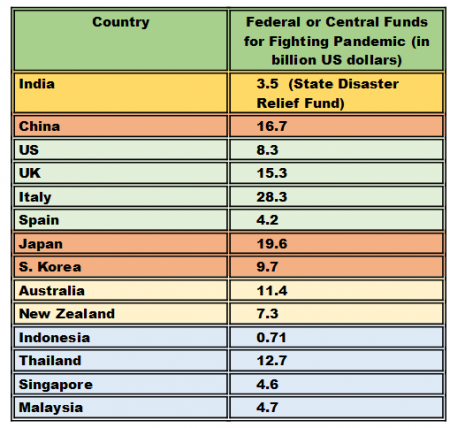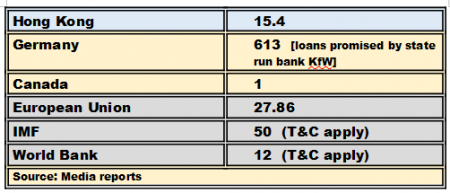Which Country Is Spending How Much to Fight Coronavirus (COVID-19)?

Image Courtesy: Khaleej Times
As the COVID-19 pandemic sweeps through the world, currently affecting 155 countries and with 1.82 lakh confirmed cases, governments are scrambling to tackle the challenge. Most of the seriously affected countries – mainly in East Asia and Europe – have rushed to loosen their purse strings and pump money into both, fighting the spread of infection as well as countering the impact it is having on people’s lives. According to latest estimates, made on the basis of reports in the media, nearly $200 billion have been pledged by governments of major economies, not counting easing of lending facilities from banks. There is valid concern that the already stuttering global economy would suffer a major shock and plunge the world into a recession. This is pushing governments to ease lending and take other fiscal measures.
The chart below summarises the latest available information on COVID-19 funding announcements for some of these major countries.


As can be seen above, the Indian government has so far announced that State Disaster Relief Fund (SDRF) should be used by state governments to tackle the looming emergency. SDRF is made up of contributions from central and state governments. As of February 27, 2020, the total funds available in SDRF were Rs 24.8 thousand core according to information put out by the Disaster Management Division of the Ministry of Home Affairs. At current exchange rates, this is roughly $3.5 billion.
Also read: COVID-19 Shakes Tourism Industry of UP, Agra Records 60% Drop in Visitors
Given the huge population of India, the abysmal state of public healthcare facilities especially in the rural areas and the almost complete lack of any free medical coverage or even insurance coverage, this measly funding is deeply worrying. India has reported only about 119 cases till now and three deaths. This could be a cause of this lack of attention. But, official statements seem to indicate that the government is currently not contemplating addressing either the public health issues nor the other costs like providing affordable food for affected families, compensation for wages lost, help to small and micro enterprises, and the demand slump that is bound to follow isolation of large segments of population.
Announcements by most of the other countries listed above need to be distinguished both in terms of quantum of funds announced, as also the existing status of public health care in the respective countries. Most of these countries already have universal health coverage, either state-funded (like the NHS in UK) or insurance-based (in US), or mixed (as in many countries of Europe). As a result, their public healthcare infrastructure is already functioning for normal circumstances. Despite that, the exponential growth in COVID-19 cases has overwhelmed the facilities, with scenes in hospitals being described as reminiscent of developing countries. So, a large part of the announced funding is going towards bolstering these facilities to meet the pandemic challenge.
But, equal attention is being paid to assist people – families – which are suffering the consequences of the disease. This includes a wide range of measures ranging from China providing at least 400 yuan to each family for daily spending if the employed person is sick or unable to work because of the lockdown to Italy providing aid for workers facing temporary lay-offs. This is a perspective that is completely absent from the Indian strategy as of now.
Many of these announcements include packages for businesses, in order to help them through this demand and supply shock. Policies accompanying funds include easier loans, deferring tax payments, one-time cash payments to welfare recipients and lower-income households; wage subsidies for small- and medium-sized firms, etc. Germany’s $613 billion is one such measure where the State-run KwF bank has been directed to make available this amount for helping businesses.
All these announcements are from federal or central governments. These are being supplemented by separate packages and relief measures by state or province governments. But in India, the central government has simply green lighted spending from the SDRF that was meant to be used by states in any case. The only central announcement on financing or fiscal issues so far seems to be a reported possibility that the RBI may inject up to Rs 1 lakh crore ($13.6 billion) as early as April, in order to maintain and preserve market confidence and financial stability. Also, the central government has reportedly asked state-run banks to approve new loans amounting to Rs 50-60,000 crore by March-end.
It seems that the Modi government is more interested in saving money rather than spending it generously to help distressed people. This appears to be very short sighted because it will lead to potential widespread distress, suffering and casualties, besides sinking the economy further. The recent hike in excise duties on petrol and diesel even as international prices are falling, indicates this brand of thinking.
Experts believe that the government needs to radically increase spending on public health, ramp up public distribution system of food items, ensure speedy measures for screening for infection, provide protective gear, mobilise the whole private healthcare system to work under government control (as Spain has done), and provide for paid sickness leaves and unemployment benefits, across the board.
Also read: Reflections from Italy Under Lockdown
Get the latest reports & analysis with people's perspective on Protests, movements & deep analytical videos, discussions of the current affairs in your Telegram app. Subscribe to NewsClick's Telegram channel & get Real-Time updates on stories, as they get published on our website.
























